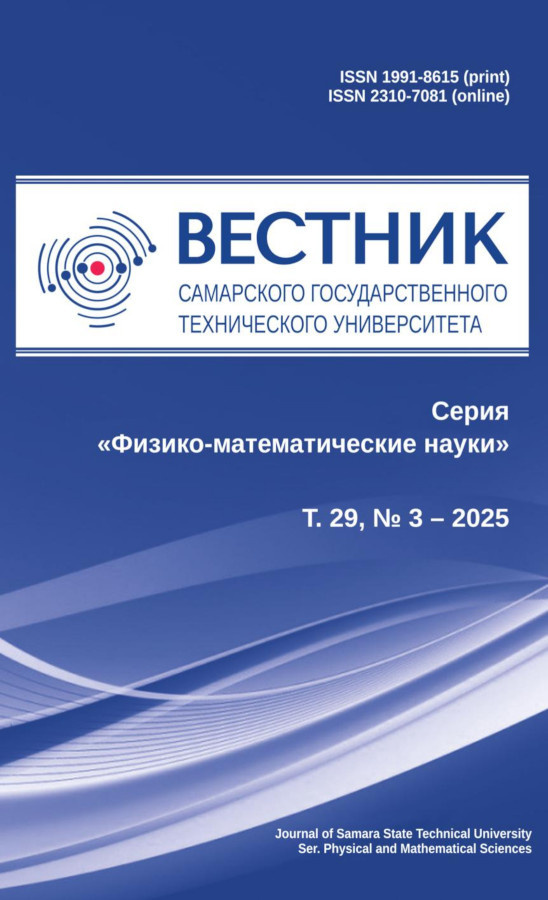Approximate solution to the Riemann problem in non-classical gas dynamics
- Authors: Koroleva M.R.1
-
Affiliations:
- Udmurt Federal Research Center of the Ural Branch of the Russian Academy of Sciences
- Issue: Vol 29, No 3 (2025)
- Pages: 503-515
- Section: Mathematical Modeling, Numerical Methods and Software Complexes
- URL: https://journal-vniispk.ru/1991-8615/article/view/349685
- DOI: https://doi.org/10.14498/vsgtu2166
- EDN: https://elibrary.ru/ASUEIW
- ID: 349685
Cite item
Full Text
Abstract
This study considers an approach to construct an approximate solver for the non-classical Riemann problem. In this regime, the solution of the discontinuity decay problem may contain composite waves, including both classical and non-classical compression and rarefaction waves. The algorithm for finding the exact solution is based on a geometric representation of shock and rarefaction waves on isentropic curves and involves the repeated use of iterative methods to solve local tasks, such as identifying inflection points on isentropes, points of tangency between a straight line and a curve, intersection points, and others. A significant challenge when using iterative methods is the need to specify initial guesses that ensure method convergence. The approach proposed in this work is based on tabulating exact solutions for Riemann problems over a wide range of initial state parameters. These tabulated data are then used to find an approximate solution without requiring iterative methods. The approximate solver was successfully applied to solve two one-dimensional discontinuity decay problems in the non-classical domain.
Full Text
##article.viewOnOriginalSite##About the authors
Mariya R. Koroleva
Udmurt Federal Research Center of the Ural Branch of the Russian Academy of Sciences
Author for correspondence.
Email: koroleva@udman.ru
ORCID iD: 0000-0001-5697-9199
https://www.mathnet.ru/rus/person73142
Cand. Phys. & Math. Sci.; Senior Researcher; Institute of Mechanics
Russian Federation, 426067, Izhevsk, T. Baramzina str., 34References
- Deville M. O. Exact solutions of the Navier–Stokes Equations, In: An Introduction to the Mechanics of Incompressible Fluids, vol. 22. Cham, Springer, 2022, pp. 51–89. DOI: https://doi.org/10.1007/978-3-031-04683-4_3.
- Nikonorova R., Siraeva D., Yulmukhametova Y. New exact solutions with a linear velocity field for the gas dynamics equations for two types of state equations, Mathematics, 2022, vol. 10, no. 1, 123. EDN: FSXDCX. DOI: https://doi.org/10.3390/math10010123.
- Prosviryakov E. Yu., Ledyankina O. A., Goruleva L. S. Exact solutions to the Navier–Stokes equations for describing the flow of multicomponent fluids with internal heat generation, Russ. Aeronaut., 2024, vol. 67, no. 1, pp. 60–69. EDN: CLAHOC. DOI: https://doi.org/10.3103/S1068799824010070.
- Brutyani M. A., Ibragimov U. G. Exact solution of the Navier–Stokes equations for rotational tornado-like flow of a viscous gas, Proc. Moscow Inst. Phys. Technol., 2024, vol. 16, no. 3(63), pp. 92–104 (In Russian). EDN: FPNPCB.
- Galkin V. A., Dubovik A. O., Morgun D. A. Visualization of flow of a viscous incompressible fluid corresponding to exact solutions of the Navier–Stokes equations, Sci. Vis., 2024, vol. 16, no. 1, pp. 52–63 (In Russian). EDN: NWGODH. DOI: https://doi.org/10.26583/sv.16.1.05.
- Guardone A., Vigevano L., Argrow B. M. Assessment of thermodynamic models for dense gas dynamics, Phys. Fluids, 2004, vol. 16, no. 11, pp. 3878–3887. DOI: https://doi.org/10.1063/1.1786791.
- Fossati M., Quartapelle L. The Riemann problem for hyperbolic equations under a nonconvex flux with two inflection points, 2014, arXiv: 1402.5906 [physics.flu-dyn].
- Quartapelle L., Castelletti L., Guardone A., Quaranta G. Solution of the Riemann problem of classical gasdynamics, J. Comput. Phys., 2003, vol. 190, no. 1, pp. 118–140. DOI: https://doi.org/10.1016/S0021-9991(03)00267-5.
- Coquelet C., Chapoy A., Richon D. Development of a new alpha function for the Peng–Robinson equation of state: Comparative study of alpha Function models for pure gases (natural gas components) and water-gas systems, Int. J. Thermophys., 2004, vol. 25, no. 1, pp. 133–158. DOI: https://doi.org/10.1023/b:ijot.0000022331.46865.2f.
- Qi J., Xu J., Han K., et al. Development and validation of a Riemann solver in Open-FOAM® for non-ideal compressible fluid dynamics, Eng. Appl. Comput. Fluid Mech., 2022, vol. 16, no. 1, pp. 116–140. DOI: https://doi.org/10.1080/19942060.2021.2002723.
- Godunov S. K., Zabrodin A. V., Ivanov M. Ya., et al. Chislennoe reshenie mnogomernykh zadach gazovoi dinamiki [Numerical Solution of Multidimensional Problems in Gas Dynamics]. Moscow, Nauka, 1976, 401 pp. (In Russian)
- Glass O. An extension of Oleinik’s inequality for general 1D scalar conservation laws, J. Hyperbolic Differ. Equ., 2008, vol. 5, no. 1, pp. 113–165. DOI: https://doi.org/10.1142/S0219891608001398.
- Zhang L., Gao G. Equations of states and polytropic processes of van der Waals gases, Phys. Eng., 2024, vol. 34, no. 3, pp. 16–21. DOI: https://doi.org/10.26599/PHYS.2024.9320303.
- Parondzhanov V. D., Mitkin S. B. The DRAKON medical algorithmic language and the DRAKON-builder program for the creation and application of clinical algorithms, Virtual Technol. Med., 2022, no. 1, pp. 32–44 (In Russian). EDN: YKCSIC. DOI: https://doi.org/10.46594/2687-0037_2022_1_1410.
- Liu T.-P. The Riemann problem for for general systems of conservation laws, J. Differ. Equ., 1975, vol. 18, no. 1, pp. 218–234. DOI: https://doi.org/10.1016/0022-0396(75)90091-1.
- Smith R. G. The Riemann problem in gasdynamics, Trans. Amer. Math. Soc., 1979, vol. 249, no. 1, pp. 1–50. DOI: https://doi.org/10.1090/S0002-9947-1979-0526309-2.
- Koroleva M. R., Tenenev V. A. Approximate Riemann solvers for the Soave–Redlich–Kwong equation of state, Russ. J. Nonlinear Dyn., 2024, vol. 20, no. 3, pp. 345–359. EDN: KFCNYJ. DOI: https://doi.org/10.20537/nd240905.
Supplementary files













